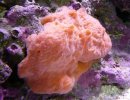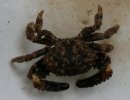Prow, Doc,
Sincerely, thanks for all the reading material and great advice. Im just diving into this hobby and while I am using all cured LR Live Sand AND the water from the LSF. I am taking my time and waiting and most importantly understanding thanks to folks like you. Numbers have temp have been steady for 3 days running but I am not planning on adding anything for at least a month. Plan on using that time to read and read and read.
planning on waiting a month and reading up in the mean time puts you leaps and bound ahead of most

My end goal is a shallow mushroom and zoa reef tank with only a couple small fish.
nice, your are doing a chronicle, with lots of pics, right

I had already put my lights on timers (unneccesary at this point) and likely to just promote the algae growth I do not want.
yup exactly.
even though your water parameters may be all good, when you increase the lighting for corals the algae could really take off on you. increasing food/energy sources ect.., at least now you can see how that can happen.
a little expanding on this;
first of all, for microalgae, ambient lighting is enough to get it growing/cycling.
now, because of how algae cycles (NH3-NO3 stuff) and our desire for bacteria to proccesses them not algae we try to control it, esp in the begining. but because algae use of photosynthesis(CO2)(will explain), at night with reduced photosynthesis, algae growth will be limited and some will die off. plus, its also the time when tiny creatures(microbes that break down waste.) like to come out, which adds nutrients, kinda. now, remember anaerobic bacteria dont care so much about lighting or O2(CO2) levels, they are wanting that NO3. but they grow slower. so, with no photosynthesis (night time) you get algae die off plus added nutrients/energy sources (NH3-NO3-CO2), with little anaerobic growth at first, nutrients accumulate as well as CO2 "energy". its not really a problem later, after things balance. however, these type things are magnified during the first month/months.
light will get in the tank anyway, unless its covered or in a dark room, and algae will grow. the die off at night will add nutrients and little to no algae grow will occur, because anaerobics grow slower and in the begining their numbers are low, an accumulation of nutrients results at night, (namely NH3-NO3 and CO2) and bloomings occur during the day (photoperiods), which spreeds the algae. again lights off, this time more die off=more nutrients added. during the next day bigger bloomings occur, all cycles increasingly repeat until the tank is fully cycled (meaning all cycles are balanced with-in themselves and with-in eachother). so think of lighting as a tool of control.
before algae gets too bad of a name: lets look at it a little closer;
algae blooms will occur and are very much needed but more for their respirations and energy(sugar). we want bacteria to deal with waste like NO3, not algae(not going into how algae eats up NH3 or NO3 here, thats a scurbber topic). however, as much as we dont want algae to be the main waste filter, we still need algae for many reasons including dealing with CO2-going to get a little tiny bit tech here:invisible ;-here i hope you we be able to see more how several processes "dynamics" interact and how it gets more tricky with the interactions amoung all this stuff:bugout: . it can get pretty advanced pretty quick, i dont want anyone to think they need to master any of this inorder to have a nice reef or even know about it:invisible if you have not totally got the previous stuff dont get to caught up in trying to understand how all this goes and works with eachother, trust me you dont need know, but there is plenty the learn about this if you wish, no need stressing on it, if you get too confused or can not follow dont worry , as long as you get the first couple posts you will have a good solid start and learn more as needed, a solid start makes for a very forgiving reef

.
ok, lets take a quick look at resprations shall we

:resprations is basically gas exchanges of CO2-O2. most know something about it happening at the water surface, as is applies to atmospheric gas exchange and CO2 levels effect on ph. but our tank are very limited in water surface area and atmospheric gas exchange, as a result our tanks, and us, use other means/methods to compensate for this and provide adequate respirations to balance things. how

we well use skimmers add buffers(react with CO2) reducing the work load on certian process like photosynthesis, kinda

we grow algae, but perfer macros because they are easier to control than micros, later corals help too, stuff like that.
as for gas exchange at the water surface, in short, really it can get complicated, is just CO2 leaving and O2 entering by way of diffusion, limited to CO2 atmospheric levels. (note; rippling of the water surface increased flow water and air flow increase the diffusion rates). but because photosynthesis and respirations are so interlinked and the carbon cycle is linked along with everything else already posted, it starts to gets twisted :dead: on how it relates, and how everything relates to everthing. you really need to recognize/be familiar with the carbon cycle becasue its really the glue, no need to master it, though

.
here is are real simple explaination
Carbon Cycle - Recycling carbon
here is a more indepth explaination.
The Carbon Cycle
ok lets, take a peek at respirations (think, O2 and CO2 exchanges)

aerobic respiration-is used by both bacteria and algae.
CO2=carbon dioxide O2=oxygen H2O=water C6H12O6=glucose(sugar)
aerobic respiration of bacteria
C6H12O6 + O2 energy to ATP > CO2 + H2O
algae as photosynthesizers(light)
CO2 + H2O light > C6H12O6 + O2
now if you look at aerobic bac and algae you see how they work togather in other ways, not only NH3-NO3 stuff, but with gas exchange aswell. stretch that out you see the cycle. the end result of aerobic bacterial respirations is the begining of photosynthesis and algae respirations. only now here we are dealing with energy sources as controls instead of nutrients(building materials) kinda

. lighting for you in this case. then it start going really advanced on how the energy(sugar production) is used in other processes. its all goes together.
here this, esp. the last couple lines, should help get photosynthesis and what i am talking about. just went into this because it does play a part in setting up things to balance in ways we want.
Photosynthesis
now, hopefully your still we me, and you can see how lighting plays a huge role in balancing things, and cycling in your lighting is just that, effects on ph-CO2-algae ect...its a domino effect that really dose effect everything, cycling your lighting to fast could result in blooms and overgrowths, however if enough anaerobic activity are present the algea blooms will be limited by anaerobic activity.
as you can see photosynthesis, repirations, carbon cycles, nitrogen cycles and others we have not even touched. phosphorus cycles, silicate cycles, water cycles ect.... all play roles, its a real ecosystem we got going on

by adding lights from day 1, too early, really helps encourage a chronic algae "problem" (perceived problem:smirk

. what i meant by a viscous cycle. now dont go to the extreme, left field, point of view, there is a lot of play here and many other factors come into play, like future additions (CUC, fish ect...). even corals effect everything. example corals use Alk which effects ph/CO2 levles which effects respirations which effects ect..., it gets crazy, too crazy and what works and is acceptable algae growth levels varies with everyone and everysystem. it really gets interesting when you look at chemistry and microbiology interactions. again though you dont need to know all this and should learn one aspect/method before going to crazy. hope when you deal with chemistry issues knowing that, that too is included in a ecosystem.
Sounds like the bio balls need to go and get replaced by a skimmer in a couple weeks if what I want is primarily a soft coral reef tank (please correct me if I misread this). Im running a 14g Biocube and its my first sw tank.
oh yeah you got it. i would not wait to remove the bio balls though. i see you are understanding how bio balls work. but will go into it a little bit again for others and add a little something more

what this bring up is another thing on bacterial culturing. that thing is the proximity of growths. what i mean is, i see you understand how bio balls only provide a surface area for aerobic bacteria to grow. which of course results in NO3 production. now because of the surface area and placement of bio balls( usually in high water flow=high O2 levels, but same if place anywhere) the aerobics will grow in that high food/energy area, on the bio balls, before they grow else where. so then the NO3 has to travel throughout the water column before anaerobic bacteria can get to it. now in this case, the algae will get the first chance to eat up the NO3, before the anaerobics have a chance. if the aerobic bacteria is encouraged to grow on the rock instead of on things like bio balls, dirty filter socks, any prefilter/spongy things, then the NO3 thats being produced is right next to the anaerobics and get eatn' up before they enter the water column and get used by algae. so, the proximity of the growing aerobics and anaerobics makes this system more efficient. can you see what i mean?
Im also noticing quite a few long (1/4" to an inch) white strands emerging from the LR. Are these feather duster worms? Anything to be worried about? I'm hoping Im identifying these correctly. They are about a mil thick at 1/4" in length and thin out to hair width as they stretch to an inch or so. when they stretch they have perpendiclular little arms (look like a really tiny skinny pipe cleaner). Anyway, thanks again for all the great info.
You guys are awesome.
sounds like spaghetti worms, good to have, eatup stuff

their population is nutrient dependant.
no problem on the info, i am just putting a little back into a hobby i get so much out of

please dont get caught up in the details of each cycle just yet. stay focussed on setting up then learn play/adjust later when your system is a bit more forgiving. just knowing the basics of each cycle is more than enough, you dont have to go into all the details of each. unless you just like to know, it does help

here is a ecosystem overview of much of the stuff that going on
Ecosystems
if you do a search on each system, there are some good charts like these;
one on the nitrgen cycle, note; where NO3 can go either to plants or bacteria
one on the carbon cycle, note; where photosynthesis takes up CO2 it also takes up NO3-how the NO3 can go to plants seen in the above chart, via photosynthesis (aka assimilation).

 I am going to have a sump tank with refugium, and I have seen that the fuge can be used as the DSB rather than the display tank.
I am going to have a sump tank with refugium, and I have seen that the fuge can be used as the DSB rather than the display tank. 



